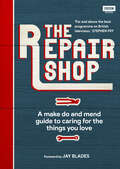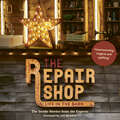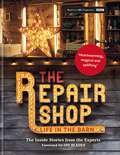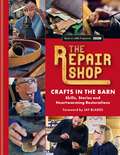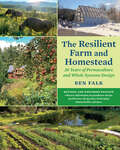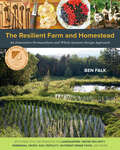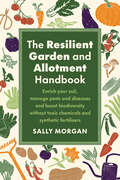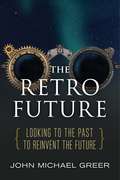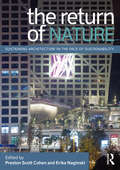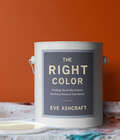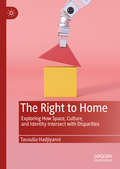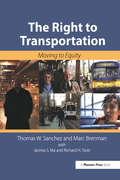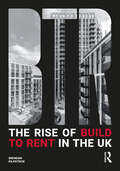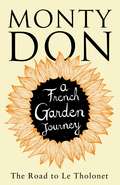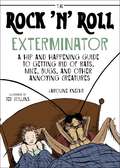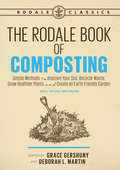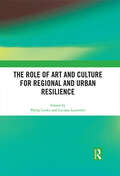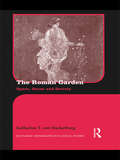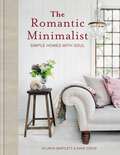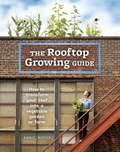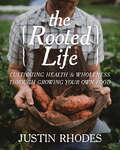- Table View
- List View
The Repair Shop: A Make Do and Mend Handbook
by Karen FarringtonTHE SUNDAY TIMES BESTSELLER AND OFFICIAL COMPANION TO THE HIT BBC SERIESBBC’s The Repair Shop is a place where Britain’s most skilled and caring craftspeople rescue and resurrect items that owners thought were beyond saving. Their shared love of craft has helped hundreds of people recover and relive cherished memories, and inspired millions to rediscover their own prized possessions. The skill required to properly restore those items may be beyond most of us, but there are small things we can all do to care for the items we love the most. How do you replenish the stuffing in your child’s beloved, tatty teddy bear, for instance? Or remove a water mark left on your wooden table? What’s the best way to prevent your leather from cracking?Direct from the Repair Shop's 'Workshop of Dreams', this ‘make do and mend’ guide collects advice and stories from each of the show’s experts, to help you understand and care for those aging treasures and heirlooms around your house or gathering dust in the garage. Whether it’s wood, ceramics, leather or silverware, you will get to know your materials, tools and terms from Britain’s best, as the Repair Shop experts share their tips on restoring and conserving, reveal their favourite tools, and provide a series of small, manageable projects that help tackle the most common problems that occur in their given medium. Their book, like the show it accompanies, with help you safeguard your sentimental legacy for generations to come.
The Repair Shop: LIFE IN THE BARN: The Inside Stories from the Experts: THE BRAND NEW BOOK FOR 2022
by Elizabeth Wilhide Jayne Dowle'Heartwarming, magical and uplifting'In today's throwaway culture, there's a counter movement growing that urges us to 'make do and mend'. The Repair Shop has brought this waste-conscious message to an even wider audience, with its regular viewing figures of 7 million in the UK alone, cementing itself as a classic series in the vein of Antiques Roadshow.This new book concentrates on the show's much-loved experts, including woodworker and furniture restorer Will Kirk, clock restorer Steve Fletcher, metalworker Dominic Chinea, silversmith Brenton West, leatherworker Suzie Fletcher, upholsterer Sonnaz Nooranvary, and seamstresses Julie Tatchell & Amanda Middleditch - aka The Teddy Bear Ladies. Each of the experts shares their own stories and their repairs, capturing in the process the magic and ethos of the barn. Includes quotations and Q & As from the experts as well as Jay Blades on some unique restoration collaborations.With the focus on the experts themselves, readers will feel as though they're stepping straight into the 'workshop of dreams' and experiencing first hand the magic of the barn.2022 Octopus Publishing Group
The Repair Shop: LIFE IN THE BARN: The Inside Stories from the Experts: THE LATEST BOOK
by Elizabeth Wilhide Jayne Dowle'Heartwarming, magical and uplifting'In today's throwaway culture, there's a counter movement growing that urges us to 'make do and mend'. The BBC's BAFTA Award winning The Repair Shop has brought this waste-conscious message to an even wider audience, with its regular viewing figures of 7 million in the UK alone, cementing itself as a classic series in the vein of Antiques Roadshow.This new book concentrates on the show's much-loved experts, including woodworker and furniture restorer Will Kirk, clock restorer Steve Fletcher, metalworker Dominic Chinea, silversmith Brenton West, leatherworker Suzie Fletcher, upholsterer Sonnaz Nooranvary, and seamstresses Julie Tatchell & Amanda Middleditch - aka The Teddy Bear Ladies. Each of the experts shares their own stories and their repairs, capturing in the process the magic and ethos of the barn. Includes quotations and Q & As from the experts as well as Jay Blades on some unique restoration collaborations.With the focus on the experts themselves, readers will feel as though they're stepping straight into the 'workshop of dreams' and experiencing first hand the magic of the barn.
The Repair Shop: LIFE IN THE BARN: The Inside Stories from the Experts: THE LATEST BOOK
by Elizabeth Wilhide Jayne Dowle'Heartwarming, magical and uplifting'In today's throwaway culture, there's a counter movement growing that urges us to 'make do and mend'. The BBC's BAFTA Award winning The Repair Shop has brought this waste-conscious message to an even wider audience, with its regular viewing figures of 7 million in the UK alone, cementing itself as a classic series in the vein of Antiques Roadshow.This new book concentrates on the show's much-loved experts, including woodworker and furniture restorer Will Kirk, clock restorer Steve Fletcher, metalworker Dominic Chinea, silversmith Brenton West, leatherworker Suzie Fletcher, upholsterer Sonnaz Nooranvary, and seamstresses Julie Tatchell & Amanda Middleditch - aka The Teddy Bear Ladies. Each of the experts shares their own stories and their repairs, capturing in the process the magic and ethos of the barn. Includes quotations and Q & As from the experts as well as Jay Blades on some unique restoration collaborations.With the focus on the experts themselves, readers will feel as though they're stepping straight into the 'workshop of dreams' and experiencing first hand the magic of the barn.
The Repair Shop: Skills, stories and heartwarming restorations: THE LATEST BOOK
by Elizabeth Wilhide Jayne DowleThe Repair Shop - the Bafta-award-winning series with regular viewing figures of 7 million in the UK alone - has cemented itself as a BBC classic. Enter a workshop filled with expert craftspeople as they bring loved pieces of family history and the memories they hold back to life.Each expert explains their craft, the reason they love it so much and how they go about restoring and reviving your precious objects, from a Ukrainian suitcase to a matchstick clock, using crafts as varied as leatherwork, woodwork, metalwork, art and ceramic restoration.
The Repair Shop: Skills, stories and heartwarming restorations: THE LATEST BOOK
by Elizabeth Wilhide Jayne DowleThe Repair Shop - the Bafta-award-winning series with regular viewing figures of 7 million in the UK alone - has cemented itself as a BBC classic. Enter a workshop filled with expert craftspeople as they bring loved pieces of family history and the memories they hold back to life.Each expert explains their craft, the reason they love it so much and how they go about restoring and reviving your precious objects, from a Ukrainian suitcase to a matchstick clock, using crafts as varied as leatherwork, woodwork, metalwork, art and ceramic restoration.
The Resilient Farm and Homestead, Revised and Expanded Edition: A Permaculture and Whole Systems Design Approach
by Ben Falk&“This is one of the most practical, down-to-earth, dirt-under-the-fingernails, comprehensive explanations of all things homesteading and small farming. Whether you&’re just dreaming or an old hand, Ben Falk&’s longer experience horizon is invaluable.&”—Joel Salatin, cofounder, Polyface Farm; author of Everything I Want to Do Is IllegalInformed by twenty years of successful land management and the professional design experience of his pioneering firm Whole Systems Design, LLC, author Ben Falk updates his classic text and delivers the definitive twenty-first century systems thinking manual in self-reliance—sure to empower readers to prioritize projects, make positive lifestyle decisions, and take strategic steps toward a regenerative future. In The Resilient Farm and Homestead, Revised and Expanded Edition Falk describes how he has transformed a degraded hillside in the frigid Vermont climate into a thriving, biodiverse Eden that now provides year-round abundance for his family and community.First published in 2013, The Resilient Farm and Homestead is a comprehensive how-to guide for building durable and productive land-based systems through the reciprocal interplay of humans and the natural world. In the ten years since he first published this seminal work, Falk has deepened his wisdom in harnessing nature-based solutions for increasingly challenging times, including addressing severe climate disruptions like drought and flood conditions.The book covers every strategy Falk and his team have tested on the Whole Systems Research Farms over the past two decades and includes detailed information on earthworks, gravity-fed water systems, soil fertility management, growing nutrient-dense food and medicine, fuelwood production, agroforestry, managed grazing, and much more.Complete with full-color photography and detailed design drawings, The Resilient Farm and Homestead, Revised and Expanded Edition includes new information on:Designing greenhouses and microclimatesReinvigorating human health and embodying a vigorous lifestyleRaising children on a homesteadCreating failure-proof and resilient energy systemsFocusing on permaculture beekeepingCultivating proven cold climate plantsOvercoming analysis paralysis and mastering the art of knowing where to start and when to take strategic risksAnd much, much more!In an age that feels defined by disconnection, disease, and decline, The Resilient Farm and Homestead, Revised and Expanded Edition offers a roadmap to conquering uncertainty, maximizing efficiency, and creating a bountiful, manageable landscape that will endure.&“Essential reading for the serious prepper as well as for everyone interested in creating a more resilient lifestyle.&”—Carol Deppe, author of The Resilient Gardener&“This intelligent, challenging book, rooted somewhere between back-to-the-land idealism and radical survivalism, sees resilience as both planting and building for the use of future generations, but also as preparing food, water, shelter, and the human body and psyche for the onset of any imaginable extreme emergency. . . . The result is a comprehensive, open-ended, theoretical and practical system for a post-carbon-dependent life.&”—Publishers Weekly (starred review of first edition)
The Resilient Farm and Homestead: An Innovative Permaculture and Whole Systems Design Approach
by Ben FalkA practical, comprehensive, and essential how-to manual with information on growing perennial crops, soil fertility, water security, nutrient dense food, and more! "Essential reading for the serious prepper as well as for everyone interested in creating a more resilient lifestyle."—Carol Deppe, author of The Resilient GardenerThe Resilient Farm and Homestead is for readers ready to not just survive, but thrive in changing, unpredictable times. It offers the tools to develop durable, beautiful, and highly functional human habitat systems anchored by preparation, regeneration, and resiliency. Ben Falk is a land designer and site developer whose research farm has drawn national attention. The site is a terraced paradise on a hillside in Vermont that would otherwise be overlooked by conventional farmers as unworkable. Falk’s wide array of fruit trees, rice paddies (relatively unheard of in the Northeast), ducks, nuts, and earth-inspired buildings is a hopeful image for the future of regenerative agriculture and modern homesteading.The book covers nearly every strategy Falk and his team have been testing at the Whole Systems Research Farm over the past decade, as well as experiments from other sites Falk has designed through his off-farm consulting business.The book includes detailed information on:Gravity-fed water systemsFuelwood hedge production and processingHuman health through nutrient-dense production strategiesRapid topsoil formation and remineralizationAgroforestry, silvopasture & grazingEarthworksSpecies compositionThe site-design process and site managementEcosystem services, especially regarding flood mitigationTools, equipment, and appropriate technology guidesA "Homestead Vulnerability" checklistResiliency Aptitude quiz and skills list for emergencies And much more!Complete with gorgeous photography and detailed design drawings throughout!The Resilient Farm and Homestead is more than just a book of tricks and theories for regenerative site development. It offers actual working results from a complex farm-ecosystems based on research from the “great thinkers” in permaculture, and presents a viable home-scale model for an intentional food-producing ecosystem in cold climates, and beyond. Inspiring to would-be homesteaders everywhere, but especially for those who find themselves with “unlikely” farming land, Falk is an inspiration in what can be done by imitating natural systems, and making the most of what we have by re-imagining what’s possible. A gorgeous case study for the homestead of the future.
The Resilient Garden and Allotment Handbook: Enrich your soil, manage pests and diseases and boost biodiversity without toxic chemicals and synthetic fertilisers
by Sally MorganCreate a thriving garden or allotment that works in harmony with nature and will flourish in the face of ever-changing environmental conditions.In The Resilient Garden and Allotment Handbook, expert organic gardener Sally Morgan shares a wide range of ecological concepts from permaculture, regenerative gardening, agroecology and more to boost your garden’s biodiversity and enrich your soil. This must-have guide will help you:Build your soil so it’s full of healthy organic matter and protect it through no-dig practices, composting, cover crops and mulchingIncrease resilience through productive plant combinations and polycultureCreate wildlife-friendly habitats utilising walls and fences, log piles, water features and wild cornersChoose the right plants to attract pollinators and plant defendersCombat disease and keep pests at bay using natural predators, companion planting and trap and barrier cropsPLUSThe importance of collecting genetically diverse seeds from plants that have adapted to local conditionsSustainably manage water in your garden, especially in times of drought or excessive rainfallWhether you’re a passionate gardener, allotment holder or grower, The Resilient Garden and Allotment Handbook will help you future-proof your garden by giving it everything it needs to adapt and succeed, whatever the climate challenge. (Previously published as The Healthy Vegetable Garden, now updated and revised)'A must-read for anyone who wants to know how to grow their own zero-food miles, pesticide-free veg, while treading gently upon our planet.' Dave Goulson, author of The Garden Jungle and Silent Earth 'This book could not be better timed, and given Sally’s lifetime experience of organic gardening, it’s bound to inspire all those who want to ‘grow back better’.' Helen Browning, Chief Executive, Soil Association
The Resilient Gardener: Food Production and Self-Reliance in Uncertain Times
by Carol Deppe"The Resilient Gardener is so essential, timely and important, and I will recommend it to everyone I know. It doesn't matter if you garden or if you don't-this is practical wisdom good for humans to know."—Deborah Madison, Author of Local Flavors and Vegetarian Cooking for EveryoneScientist/gardener Carol Deppe combines her passion for organic gardening with newly emerging scientific information from many fields — resilience science, climatology, climate change, ecology, anthropology, paleontology, sustainable agriculture, nutrition, health, and medicine. In the last half of The Resilient Gardener, Deppe extends and illustrates these principles with detailed information about growing and using five key crops: potatoes, corn, beans, squash, and eggs.In this book you&’ll learn how to:•Garden in an era of unpredictable weather and climate change•Grow, store, and use more of your own staple crops•Garden efficiently and comfortably (even if you have a bad back)•Grow, store, and cook different varieties of potatoes and save your own potato seed•Grow the right varieties of corn to make your own gourmet-quality fast-cooking polenta, cornbread, parched corn, corn cakes, pancakes and even savory corn gravy•Make whole-grain, corn-based breads and cakes using the author&’s original gluten-free recipes involving no other grains, artificial binders, or dairy products•Grow and use popbeans and other grain legumes•Grow, store, and use summer, winter, and drying squash•Keep a home laying flock of ducks or chickens; integrate them with your gardening, and grow most of their feed.The Resilient Gardener is both a conceptual and a hands-on organic gardening book, and is suitable for vegetable gardeners at all levels of experience. Resilience here is broadly conceived and encompasses a full range of problems, from personal hard times such as injuries, family crises, financial problems, health problems, and special dietary needs (gluten intolerance, food allergies, carbohydrate sensitivity, and a need for weight control) to serious regional and global disasters and climate change. It is a supremely optimistic as well as realistic book about how resilient gardeners and their vegetable gardens can flourish even in challenging times and help their communities to survive and thrive through everything that comes their way — from tomorrow through the next thousand years. Organic gardening, vegetable gardening, self-sufficiency, subsistence gardening, gluten-free living."The Resilient Gardener is brilliantly timely, and shows us how to create gardens that can survive our increasingly erratic weather, while supplying key nutrition lacking in most vegetable gardens. This book fills a critical niche, and I recommend it unreservedly."—Toby Hemenway, author of Gaia's Garden: A Guide to Home-Scale Permaculture
The Retro Future: Looking to the Past to Reinvent the Future
by John Michael GreerThe author of The Long Descent examines a solution for the troubles of our modern age: technical regression.To most people paying attention to the collision between industrial society and the hard limits of a finite planet, it’s clear that things are going very, very wrong. We no longer have unlimited time and resources to deal with the crises that define our future, and the options are limited to the tools we have on hand right now.This book is about one very powerful option: deliberate technological regression.Technological regression isn’t about “going back”—it’s about using the past as a resource to meet the needs of the present. It starts from the recognition that older technologies generally use fewer resources and cost less than modern equivalents, and it embraces the heresy of technological choice—our ability to choose or refuse the technologies pushed by corporate interests.People are already ditching smartphones and going back to “dumb phones” and land lines and e-book sales are declining while printed books rebound. Clear signs among many that blind faith in progress is faltering and opening up the possibility that the best way forward may well involve going back.A must-read for anyone willing to think the unthinkable and embrace the possibilities of a retro future.Praise for The Retro Future“Whether or not you accept John Michael Greer’s argument that a deindustrialized future is inevitable, you’ll appreciate his call for the freedom to select the best technologies of the past—worthy and sustainable tools, not pernicious prosthetics. Greer’s vision of a “post-progress” world is clear, smart, and ultimately hopeful.” —Richard Polt, professor of philosophy, Xavier University; author, The Typewriter Revolution: A Typist’s Companion for the 21st Century“What might your life be like without an automobile, TV, or a mobile phone? Ask John Michael Greer, who lives that way and recommends it as practice for the soon-to-be-normal. Greer says we are embarked upon the post-progress era. Climate change, loose nukes, and resource exhaustion are among its many challenges. In The Retro Future, Greer looks backward to mark the way forward.” —Albert Bates, author, The Post-Petroleum Survival Guide, The Biochar Solution, and The Paris Agreement
The Return of Nature: Sustaining Architecture in the Face of Sustainability
by Preston Scott Cohen Erika NaginskiThe Return of Nature asks you to critique your conception of nature and your approach to architectural sustainability and green design. What do the terms mean? Are they de facto design requirements? Or are they unintended design replacements? The book is divided into five parts giving you multiple viewpoints on the role of the relations between architecture, nature, technology, and culture. A detailed case study of a built project concludes each part to help you translate theory into practice. This holistic approach will allow you to formulate your own theory and to adjust your practice based on your findings. Will you provoke change, design architecture that responds to change, or both? Coedited by an architect and a historian, the book features new essays by Robert Levit, Catherine Ingraham, Sylvia Lavin, Barry Bergdoll, K. Michael Hays, Diane Lewis, Andrew Payne, Mark Jarzombek, Jean-Francois Chevrier, Elizabeth Diller, Antoine Picon, and Jorge Silvetti. Five case studies document the work of MOS Architects, Michael Bell Architecture, Steven Holl Architects, George L. Legendre, and Preston Scott Cohen.
The Right Color
by Eve AshcraftThe definitive guide to paint by the nation’s most sought-after color consultantWhen Martha Stewart was developing her first paint collection, the Araucana Colors (based on the hues of her chickens’ eggs), she turned to the nation’s top color consultant: Eve Ashcraft. Eve helped Martha to pinpoint the colors of that enormously successful paint line, thus assisting in transforming an industry along the way. In her first book, The Right Color, her own curated palette (her paint line launches this fall) and countless other favorite shades and color combinations provide inspiration for every room in the house. Packed with trade secrets, such as how to make a small room look bigger, how to use color to brighten a space, and how to use paint to resolve myriad architectural challenges, this book will give anyone the confidence to choose a palette that will make the most of any space.
The Right to Home: Exploring How Space, Culture, and Identity Intersect with Disparities
by Tasoulla HadjiyanniThis book explores how the design characteristics of homes can support or suppress individuals’ attempts to create meaning in their lives, which in turn, impacts well-being and delineates the production of health, income, and educational disparities within homes and communities. According to the author, the physical realities of living space—such as how kitchen layouts restrict cooking and the size of social areas limits gatherings with friends, or how dining tables can shape aspirations—have a salient connection to the beliefs, culture, and happiness of the individuals in the space. The book’s purpose is to examine the human capacity to create meaning and to rally home mediators (scholars, educators, design practitioners, policy makes, and advocates) to work toward Culturally Enriched Communities in which everyone can thrive. The volume includes stories from Hmong, Somali, Mexican, Ojibwe, and African American individuals living in Minnesota to show how space intersects with race, gender, citizenship, ability, religion, and ethnicity, positing that social inequalities are partially spatially constructed and are, therefore, malleable.
The Right to Transportation: Moving to Equity
by Thomas SanchezDoes transportation affect the lives of minority, low-income, elderly, and physically disabled citizens? The answer is yes, and those effects can be profound, according to The Right to Transportation. The authors argue that transportation policies can limit access to education, jobs, and services for some individuals while undermining the economy and social cohesion of entire communities. Policies that have nurtured the U.S. highway system and let public transportation wither have also led to ghettos and social isolation. More and more communities are recognizing the problem. This book explains the strategies and policies that can address inequities in the nation's transportation and transportation planning systems so that the benefits and burdens of those systems can be shared equally across all communities. With a close examination of how transportation policies affect individuals and communities, the book is a guide to transportation fairness. It explains the demographic trends, historical events, and current policies that have shaped transportation in the U.S. and offers recommendations for moving to equity.
The Rise of Build to Rent in the UK
by Brendan KilpatrickBuild to Rent (BTR) is a form of residential tenure which first emerged in the United States, where it is known as Multifamily Housing. While it has been a mature asset in the United States for over a decade, it is relatively new to the UK and Ireland. The Rise of Build to Rent in the UK examines how this type of housing can play a key role in streamlining design and construction activity in a forward-facing manner which embraces climate change resilience and digital methods for delivery and management within the circular economy. The book examines the background of traditional UK home-owning and renting from which this new sector emerged, and charts BTR’s momentum swing in 2016 and on-going expansion to the present day, describing the potential of the BTR model in terms of both economic and climate sustainability and evaluating the key ingredients to success. The Rise of Build to Rent in the UK concludes with five highly illustrated UK case studies which evaluate the practical deliverability of real world BTR projects. This book will be of interest to BTR operators and investors, constructors, housing associations, municipal authorities and students of architecture and urban planning.
The Road to Le Tholonet: A French Garden Journey
by Monty DonThis is not a book about French Gardens. It is the story of a man travelling round France visiting a few selected French gardens on the way.Owners, intrigues, affairs, marriages, feuds, thwarted ambitions and desires, the largely unnamed ordinary gardeners, wars, plots and natural disasters run through every garden older than a generation or two and fill every corner of the grander historical ones. Families marry. Gardeners are poached. Political allegiances forged and shattered. The human trail crosses from garden to garden. They sit in their surrounding landscape, not as isolated islands but attached umbilically to it, sharing the geology, the weather, food, climate, local folklore, accent and cultural identity. Wines must be drunk and food tasted. Recipes found and compared. The perfect tarte-tartin pursued. None of these things can be ignored or separated from the shape and size of parterre, fountain, herbaceous border or pottager. So this is a book filled with stories and information, some of it about French gardens and gardening, but most of it about what makes France unlike anywhere else.From historical gardens like Versailles,Vaux le Vicomte and Courances to the kitchen gardens of the Michelin chef Alain Passard. There will be grand potagers like Villandry and La Prieure D'Orsan and allotments and back gardens spotted on the way. Monty also celebrates the obvious French associations of food and wine and finds gardens dedicated to vegetables, herbs and fruit.It is a book that any visitor to France, whether gardeners or not, will want to read both as a guide and an inspiration. It is a portal to get under the French cultural skin and to understand the country, in all its huge variety and disparity, a little better.
The Rock 'N' Roll Exterminator: A Hip and Happening Guide to Getting Rid of Rats, Mice, Bugs, and Other Annoying Creatures
by Caroline Knecht Jed CollinsThe Rock 'N' Roll Exterminator: A Hip and Happening Guide to Getting Rid of Rats, Mice, Bugs, and Other Annoying Creatures is a fun, practical, and easy-to-read guide to getting rid of pests in your home. It's more than just a how-to guide: it's a humorous yet useful look at the simple reality of both city and rural living.The Rock 'N' Roll Exterminator features real-life horror stories and pest tales. You'll laugh. You'll cry. You'll never look at an open box of cereal the same way again.Includes strategies for getting rid of:MiceRatsBedbugsCockroachesand more!
The Rodale Book of Composting, Newly Revised and Updated: Simple Methods to Improve Your Soil, Recycle Waste, Grow Healthier Plants, and Create an Earth-Friendly Garden
by Grace Gershuny L. Martin DeborahAn essential guide to composting for all gardeners and environmentally conscious peopleThis revised edition of The Rodale Book of Composting includes all the latest in new techniques, technology, and equipment. Gardeners know composting is the best way to feed the soil and turn food scraps into fresh produce, but even urbanites can get on board thanks to programs like compost pickup and citywide food waste initiatives—there’s no better way to reduce landfill waste (and subsequent emissions) and dependence on fossil fuels while nourishing the earth. The Rodale Book of Composting offers easy-to-follow instructions for making and using compost; helpful tips for apartment dwellers, suburbanites, farmers, and community leaders; and ecologically sound solutions to growing waste-disposal problems.
The Role of Art and Culture for Regional and Urban Resilience
by Philip Cooke Luciana LazzerettiThis book analyses the influence of art and culture as an engine to promote the resilience of regional and urban economies. Under a multidiscplinary perspective, the book examines the contribution of some creative regions and cities as places in which processes of transformation, innovation and growth are activated in response to external pressures. Through different theoretical frameworks and empirical investigations and suggesting a critical discussion of the notion of resilience, the authors argue that cultural and creative resources may offer a sustainable model in order to afford different typologies of shocks. The book will appeal scholars of regional and urban science and cultural and creative economies and will open up a number of considerations for policy makers.This volume was originally published as a special issue of European Planning Studies.
The Roman Garden: Space, Sense, and Society (Routledge Monographs in Classical Studies)
by Katharine T. von StackelbergThis innovative book is the first comprehensive study of ancient Roman gardens to combine literary and archaeological evidence with contemporary space theory. It applies a variety of interdisciplinary methods including access analysis, literary and gender theory to offer a critical framework for interpreting Roman gardens as physical sites and representations. The Roman Garden: Space, Sense, and Society examines how the garden functioned as a conceptual, sensual and physical space in Roman society, and its use as a vehicle of cultural communication. Readers will learn not only about the content and development of the Roman garden, but also how they promoted memories and experiences. It includes a detailed original analysis of garden terminology and concludes with three case studies on the House of Octavius Quartio and the House of the Menander in Pompeii, Pliny’s Tuscan garden, and Caligula’s Horti Lamiani in Rome. Providing both an introduction and an advanced analysis, this is a valuable and original addition to the growing scholarship in ancient gardens and will complement courses on Roman history, landscape archaeology and environmental history.
The Romantic Minimalist: Simple Homes with Soul
by Atlanta Bartlett Dave Coote'Atlanta and Dave's unique blend of nostalgic romanticism combined with a thoughtful approach to sustainability and slow living, makes this book a dream for anyone interested in how to live with vintage and antiques without succumbing to clutter or consumerism.'Paula Sutton - Hill House Vintage'A book for those who fall between the all-out riot that is maximalism and the rigidity of minimalism, the authors lead you gently down a middle path where it's about layering textures to create comfort and character without overwhelming the senses. If there is such a thing as mindful decorating this is it.' Kate Watson-Smyth - Mad About the House'Atlanta and Dave have a unique talent to build, rework and decorate properties with a functional and romantic flow. Using reclaimed and authentic elements is a signature of their work and creates charming and timeless homes.' Rachel Ashwell - Founder of Shabby Chic'Atlanta and Dave prove that their beautiful beachy aesthetic is easy to achieve in this stylish book, which is a celebration of pared back, timeless interiors. I'd love to live in every one.' Sarah Tomczak - Editor in Chief Red Magazine'I have admired Atlanta and Dave for many years! They stand as a true trailblazers in British vintage interiors. Her aesthetic exudes a sense of timeless beauty and sophistication.' Pearl LoweIn this timely interiors book, design duo Atlanta Bartlett and Dave Coote explore a new type of minimalism. The emphasis is on appreciating the imperfect, encouraging self-expression and never compromising on comfort.This new minimalism has romance and nostalgia at its heart. It celebrates the plain and simple things in life; loves old, time-worn treasures; shuns materialism in favour of sustainability and creates a home to soothe the soul. The book includes stunningly photographed case studies of homes, alongside chapters on topics ranging from working with colour and textiles, to sustainability and sourcing found objects from nature. This is the perfect manual for curating elegant and soothing living spaces.
The Romantic Minimalist: Simple Homes with Soul
by Atlanta Bartlett Dave Coote'Atlanta and Dave's unique blend of nostalgic romanticism combined with a thoughtful approach to sustainability and slow living, makes this book a dream for anyone interested in how to live with vintage and antiques without succumbing to clutter or consumerism.'Paula Sutton - Hill House Vintage'A book for those who fall between the all-out riot that is maximalism and the rigidity of minimalism, the authors lead you gently down a middle path where it's about layering textures to create comfort and character without overwhelming the senses. If there is such a thing as mindful decorating this is it.' Kate Watson-Smyth - Mad About the House'Atlanta and Dave have a unique talent to build, rework and decorate properties with a functional and romantic flow. Using reclaimed and authentic elements is a signature of their work and creates charming and timeless homes.' Rachel Ashwell - Founder of Shabby Chic'Atlanta and Dave prove that their beautiful beachy aesthetic is easy to achieve in this stylish book, which is a celebration of pared back, timeless interiors. I'd love to live in every one.' Sarah Tomczak - Editor in Chief Red Magazine'I have admired Atlanta and Dave for many years! They stand as a true trailblazers in British vintage interiors. Her aesthetic exudes a sense of timeless beauty and sophistication.' Pearl LoweIn this timely interiors book, design duo Atlanta Bartlett and Dave Coote explore a new type of minimalism. The emphasis is on appreciating the imperfect, encouraging self-expression and never compromising on comfort.This new minimalism has romance and nostalgia at its heart. It celebrates the plain and simple things in life; loves old, time-worn treasures; shuns materialism in favour of sustainability and creates a home to soothe the soul. The book includes stunningly photographed case studies of homes, alongside chapters on topics ranging from working with colour and textiles, to sustainability and sourcing found objects from nature. This is the perfect manual for curating elegant and soothing living spaces.
The Rooftop Growing Guide
by Annie NovakTapping into the expanding market for rooftop farming and green roofs, this is the first stylish, easy-to-use book for urban gardeners interested in utilizing their roof space for growing food. If you'd like to grow your own food but don't think you have the space, look up! In urban and suburban areas across the country, farms and gardens are growing atop the rooftops of residential and commercial buildings. In this accessible guide, author Annie Novak's passion shines as she draws on her experience as a pioneering sky-high farmer to teach best practices for raising vegetables, herbs, flowers, and trees. The book also includes interviews, expert essays, and farm and garden profiles from across the country, so you'll find advice that works no matter where you live. Featuring the brass tacks on green roofs, container gardening, hydroponics, greenhouse growing, crop planning, pest management, harvesting tips, and more, The Rooftop Growing Guide will have you reimagining the possibilities of your own skyline.From the Trade Paperback edition.
The Rooted Life: Cultivating Health and Wholeness Through Growing Your Own Food
by Justin RhodesA permaculture expert and popular YouTube Homesteader shares the skills and the delights of becoming a part of your own food story in this inspiring, accessible, and beautiful invitation to a more abundant, healthy, and connected life. Have you ever wanted to experiment with growing your own food but didn&’t think you had the space, the time, or the knowledge? Justin Rhodes thought the same thing—until after years battling systemic illness and struggling to provide the kind of wholesome food he wanted for his family, he bought a seed packet at the grocery store and was hooked! Justin discovered the miraculous potential and empowerment of working with nature to grow food for his family, and since that discovery, he has shared his self-taught skills with hundreds of thousands of growers via his popular YouTube channel and website. Whether you're looking for greater food security, better health, tastier food, to save or earn money, connect with your food source, this book is for you. If you're looking for a different kind of life—a life focused on health and wellness—take a look down the road less traveled.Looking for every opportunity to pass his hard-earned knowledge onto others, Justin Rhodes created this inspiring and practical invitation to growing your own food and experiencing a more connected, sustainable lifestyle, no matter where you live or how much space you have. Filled with beautiful and inspiring photographs from the Rhodes&’ homestead and chock full of resources, including gardening plans, everything you need to know about raising chickens, tips for how to get your kids involved, and even recipes for how to serve up your home-grown goodness, The Rooted Life provides you with the inspiration, the encouragement, and the practical wisdom that you need to begin the journey to a more rooted life.
